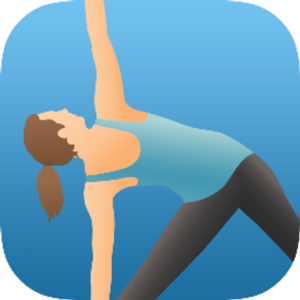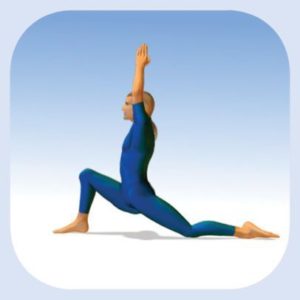Yoga has become increasingly more popular over the last few years. It is well-known that is increases your flexibility, helps tone your muscles, and can provide significant stress relief. Thanks to the advancement of technology, you don’t even need to leave your home when you invest in a quality yoga app.
We reviewed some of the best yoga apps on the market to help you choose the best one.
Rankings
1. Grokker

Grokker is a workout app that focuses on yoga, but also includes things like HIIT and Pilates. With thousands of fitness videos and helpful filters, you can find a video for practically everything on this app.
Plus, they even include videos on healthy eating and self-help topics for a complete wellness experience. For these reasons, it is our #1 pick.
2. Daily Yoga

For beginners and advanced practitioners alike, you can’t beat Daily Yoga.
This app includes programs of all sorts of you to take advantage of, including beginner programs and programs that focus on a particular muscle group. For beginners, they offer a specialized 2-week course to get you in the grove.
3. The Underbelly

This app is terrific for anyone trying to get in shape. It is super body-positive and includes tons of different videos for varying body types. They are adding new videos all the time along all their different tracks, so you’ll never get bored.
Plus, the app is generally quite cheap compared to other options.
4. Glo

Glo focuses on yoga, but also includes similar workout options like Pilates as well as meditation. When you first sign up, it does give you suggested classes to try – which is especially helpful since there are almost 4,000 videos on the app.
The filters on this app are beneficial and range from muscle group to level of difficulty.
5. Pocket Yoga

Aimed mostly at beginners, this app includes an extensive breakdown of every pose in their comprehensive “pose dictionary.” It also includes a variety of classes that range from 5 minutes to a full hour.
The instructor is animated, unlike the real-person instructors most other apps feature.
6. Asana Rebel

For more advanced yoga practitioners, this app might be a better choice. It is more intense and fast-paced when compared to other apps, with more emphasis placed on fat-burning.
There are tons of different options to choose from when it comes to classes. They even have 5-minute mini-workouts.
7. Yoga Studio

This app is for both yoga and meditation. It is free, though some videos do require you to purchase them.
Plus, this app also allows you to design your class using their pose-by-pose building option. This feature alone elevated this app onto our top 10 list.
8. Five Minute Yoga Workouts

This app does exactly what you’d expect. It provides 5-minute yoga classes. There are many different flows available, but none of them last longer than 5-minutes. Each pose comes with a clear image and detailed instructions, making it suitable for beginners.
Perhaps most importantly, this app is entirely free.
9. Yoga Workouts by Daily Burn

For personalized yoga videos and plans, this app is a solid choice. It customizes your weekly yoga plan based on your fitness level and specific goals.
All plans are downloadable, so you can use them wherever you are, whether you have internet access or not.
10. Down Dog

With an incredible number of videos (to the tune of 30,000), this app is perfect for those who always want to try something new.
It helps you find your perfect video based on your experience, the type of workout you want, what you want to focus on, how much time you have, and more.
How We Ranked
When we were ranking each app, we first considered the number of videos or workout options an app included. Some apps only had a hundred or so, which would make it difficult for a user to find what they were looking for. If an app has minimal options, the odds of it being the only app you need are low.
Because many of these apps are paid, we only ranked apps high if they could provide a complete practice in themselves. No one wants to need two different paid yoga apps.
Secondly, we considered the cost and overall value of each app. Certain apps might cost $10, but only provide 1,000 videos of a limited variety. Other apps might cost that same amount, but included many more videos and sometimes even feature other workout routines besides yoga, like Pilates. These apps got rated higher because they provide users with more value for their money.
Thirdly, we also took into account the types of workouts included. All the apps in our rankings section include yoga. However, some included other workout types as well. Usually, these workouts were somewhat related to yoga, such as Pilates.
Many apps also included meditation, which often goes hand-in-hand with yoga. Others even included different wellness videos, including those focused on cooking or more vague self-care topics.
Variety is generally considered king when it comes to these apps. Otherwise, you’ll quickly become bored or find that the app doesn’t have what you’re looking for. Because of this, we ranked apps with a wider variety higher.
Finally, we also considered how easy the app was to use. Many apps included beginner videos, but this was not always true. Apps that expected users to have some sort of previous experience got rated lower. This was a significant reason why Asana Rebel was rated lower on our list; it just didn’t have many videos that beginners could use.
Benefits
Yoga apps are superior or equal to other workouts apps in almost every outcome. A review of the current scientific literature found that yoga is often superior or equal workout choice when compared to other workout options (1). Yoga is usually better for your overall physical and mental health. It can help to better regulate specific systems in your body, such as your sympathetic nervous system, which controls your stress response. Physical fitness was the only area where yoga did not outperform other exercises.
Because of this, you may be better off choosing a yoga app than some other fitness app, especially if your main goal isn’t to get more physically fit. Yoga apps are especially the better choice if you want better mental health outcomes.
Yoga apps can be helpful for cancer survivors. If you are a cancer survivor, studies have found that yoga might be of particular benefit to you (2).
In one particular study, a group of eligible participants was put on a 7-week yoga program. All participants were tested on specific physical and psychological factors before and after the trial. The study mainly focused on breast cancer survivors, and therefore, most of the participants were females around 50 years of age. They also used a control group that was not given the yoga program.
There were significant differences between the yoga group and the control group by the end of the seven weeks. In almost every way, the group that did the yoga course was rated better on roughly ever measured variable, including quality of life, emotional function, and even physical symptoms like digestive upset.
Future research is still needed to determine whether yoga is useful for all cancer survivors and whether men can benefit as well. However, these findings point out that yoga might be helpful for those with certain health conditions, including cancer.
Yoga apps may be beneficial for lowering diastolic blood pressure. If you have blood pressure problems, scientific studies have shown that yoga can help you reduce it. In a smaller study that followed 26 participants of various ages, many participants had significantly lower blood pressure after six weeks (3).
High blood pressure is associated with a variety of adverse outcomes, like heart disease, so using a yoga app regularly could potentially lower your chances of experiencing these diseases.
It is essential to point out that certain types of yoga lower your blood pressure better than others. In the study, Astanga yoga was associated with a more significant decrease in diastolic blood pressure.
Yoga apps can increase strength and endurance. First and foremost, yoga is a type of exercise. While yoga tends to focus on peace of mind and wellness more than other types of exercises, it is still focused on improving your physical fitness.
Studies have found that yoga does this quite well (3). Nearly all participants followed by one study had better muscle endurance and strength at the end of six weeks than they started with.
Again, the exact type of yoga you do here matters. Astanga yoga is better at improving upper body strength than hatha yoga, for instance. However, they are about equal when it comes to increasing trunk space.
Luckily, a good yoga app will include many different types of yoga on it, allowing you to try all of them equally and take advantage of the benefits they offer.
Yoga apps can reduce stress. On top of the usual physical benefits, yoga has also been shown to have significantly higher stress management effects than other types of exercise (3, 4). In yoga, certain physical forms are emphasized, as is physical awareness. This can have a direct effect on your stress level, and the physical symptoms stress often brings with it. When your body is relaxed, your mind usually relaxes as well.
Furthermore, some types of yoga focus on breathing techniques, which have been shown to reduce stress, as well. Some also include forms of meditation, especially at the end of the physical exercise, which can reduce your overall stress as well.
When performed regularly, yoga can reduce your stress levels and make you more resilient to stressful conditions.
Through the use of yoga apps, you can do yoga whenever you feel stressed and need some time to unwind. In this way, yoga apps provide a unique stress management tool you can use almost anywhere. Some apps even have yoga videos specifically designed for stress reduction as well as videos that just include meditations.
Yoga apps can improve your physical health. One study found that nearly everyone who practiced yoga felt that their overall health had improved (5). Almost all participants reported at least excellent health, with almost 39% reporting excellent health. This was despite a statistically high number of people with a chronic health problem – 60%.
This can likely be explained by the fact that those who have a chronic health condition might be more likely to take up yoga in an attempt to improve their overall health. Then, as they began practicing yoga, their overall health went up, though they still had their chronic illness. This suggests that yoga can improve the health of even those with chronic disease, though it is uncertain whether practicing yoga before the development of these conditions decreases the chance of them occurring.
Many also indicated that yoga improved their sleep and weight, which are both very important for physical wellness. The vast majority reported increased energy, as well.
Yoga apps can improve your mental health. The same study also found that yoga could increase a participant’s mental health (5). Nearly everyone reported moderate mental health or flourishing mental health. Similarly to the previous benefit, this was despite a high amount of reported depression at 24.8%.
Again, this is likely because those who have depression are more likely to take up yoga in an attempt to improve their mental health. Therefore, many participants reported having depression. However, their yoga practiced had improved their overall mental health, causing them to report moderate to high mental health levels.
While there have been very few studies on the direct effect of yoga on mental health, this study does hint at the idea that yoga might improve your overall mental health levels.
Yoga apps can be useful for adolescents and children. There have been many studies done on yoga in a school setting, and the vast majority of them have reported positive outcomes.
One particular study followed a group of high school students as they took a yoga class instead of their usual physical education class. There was also a group of studies in a regular physical education class they used as their control group (6). Every student went through several tests before and after their class periods. These tests elated to things like mood and anxiety.
In the end, those in the usual PE class reported lower mood levels and high levels of anxiety. In other words, they worsened over the semester. However, those in the yoga class reported improved mood and anxiety levels. Plus, those in the yoga class also rated the course higher.
Other similar studies have been done, and many mirror these outcomes. Because of this, you may want to consider choosing a yoga app for your teens and children as well. Many apps have routines that can be used by parents and children, allowing you to spend time with your child while also supporting their physical and mental health.
Yoga apps can be useful for pregnant women. One study found that pregnant women who practice yoga might have easier labors and less pain during pregnancy (7). This particular study followed 74 women in Thailand who were pregnant. Some of the women were given a yoga program that involved six, 1-hour sessions a week, while the other women did not practice yoga.
The group of women who did yoga reported lower levels of pain during labor and after labor. They also had shorter labors overall. Both groups reported increasing discomfort and pain as their pregnancy progressed. There were no effects on the newborn as far as the study could see.
Downloading and using a yoga app while you’re pregnant can decrease the overall amount of pain you feel during labor as well as decrease the length of your labor.
Side Effects
Yoga apps can cause back pain. One study took a survey to determine the severity of yoga-induced injuries among those who practiced yoga. The most common reported side effect was back pain, though users also said pain relating to musculoskeletal regions, like their joints (8).
However, the overall number of reported injuries was deficient and less than 1% said that their injury prevented them from practicing yoga in the future. Plus, only one-third of those who reported back pain sought medical attention. Based on these statistics, we can see that their back pain was likely not very serious and cleared up quickly on their own.
Of course, we also don’t know if their back pain was directly related to yoga or caused by something else. It was probably the result of several factors.
Yoga apps can cause injury. If you push yourself too much when using an app or jump into advanced forms too quickly, you do risk injury. One study found that 62% of those who practice yoga will get injured at one point or another and be affected by that injury for at least one month. In other words, yoga is no expectation when it comes to fitness injuries (9).
This study also found that the rate of injury was 1.18 per 1,000 hours of practice. If you practice yoga for an hour every day, this means you’ll probably get injured once every three years. If you count reoccurring injuries than it is around 1.45 injuries per 1,000 hours of practice. Of course, most people do not practice yoga this much. The less you work out, the lower your chance of getting injured. Of course, this could be said for any activity.
Injuries appeared to be most common in the lower extremities, like the hamstrings and knees. None of the participants in the study reported severe injuries, though.
The chance might be slightly higher with yoga apps, as there is not a real-life teacher there to correct your posture or help you adjust the poses to your needs.
Recommended Usage
Most studies on the benefits of yoga have participants doing yoga around six days a week for an hour. You can aim to do the same amount using your yoga app or a different amount. Of course, the more you practice yoga, the more benefits you are likely to receive from it.
With that said, it is relevant not to overdue yoga as well. Even though more forms of yoga are pretty gentle, they can still cause injury, as we have discussed. Injury is more likely to occur when you don’t give your body enough time to rest, which can make doing certain poses difficult. If you are sore at all, you should let your body recover before deciding to use your app again.
The type of yoga you do also affects how often you should practice. Some forms of yoga are very gentle, while others are more intense. Intense forms of yoga, like Astanga, should be done less often than more gentle, slow types. If you do other physical fitness exercises as well, that should be taken into consideration. Your body can only do so much, even if you’re practicing different workout styles.
Finally, if you injure yourself, you should not continue using your app until you are completely recovered. Injuries often start small and then get worse as you continue to aggravate them. Because of this, you must stop and let your body rest whenever you have any sort of injury. When in doubt, tale a break.
FAQ
What are the best yoga apps? We looked at tons of different yoga apps and concluded that Grokker is the best app you can purchase. It includes yoga, as well as other exercise types, like HIIT and Pilates. It also includes general wellness videos, such as videos about cooking and meditation. Because of all these different video options, it quickly rose to our #1 pick.
We also liked the Daily Yoga app, which has a sharper focus on yoga only. This app features over 100 different yoga and meditation classes for you to stream, as well as a variety of niche tutorials. They have a whole series for beginners if you’re new to yoga. It logs all of your data, allowing you to keep track of your yoga sessions with ease.
Are there free yoga apps? Many of the apps we discussed in our rankings section come with a free version, but many apps are mostly free as well. Five Minute Yoga is entirely free. As you can probably guess, all the yoga workouts on this app last for only five minutes – which can be good or bad depending on your situation.
This app has a variety of exercises for you to choose from and is straightforward to use. It is entirely more uncomplicated when compared to other apps, though, which decreases the longevity of the app. It may not keep you entertained for very long. However, it is free, so you can’t beat it.
How do I start doing yoga at home? The easiest way to start doing yoga at home is to download an app with a solid beginner’s program. Daily Yoga is an excellent choice for this, as they come with a complete beginner’s tutorial that spans many videos. You can start by working through these videos and building a solid foundation. They start very basic and slowly get harder.
Then, you can move onto other easy videos. Most apps allow you to sort videos by difficulty. If you’re a beginner, be sure to start with easy videos. Jumping into a painful video is not only discouraging, but it can also cause difficulty. Plus, many more advanced yoga apps are nearly impossible for beginners that haven’t built up their flexibility.
From there, you can continue building up your skills and trying out different yoga styles. Eventually, you will probably have a personal preference when it comes to the style of yoga you do. In the beginning, though, feel free to try out multiple different styles for a well-balanced practice.
Can yoga apps help you lose weight? Yes. Studies have shown that yoga can help you lose weight. There are many different types of yoga, however. Different styles have different fat-burning potentials. More intense forms that involve a lot of movement and raise your heart rate more are likely to result in more weight loss than “gentle” yoga.
With that said, though, all types of yoga involve movement and, therefore, are going to help you burn calories.
Which yoga apps are for beginners? There isn’t a specific type of yoga or yoga app that is designed for beginners. Some yoga styles are more complicated than others, but you can theoretically start in any manner you want. Some apps have beginner tutorials, but you don’t have to take a tutorial to start with yoga. Instead, you can opt for a smoother video and just learn as you go.
Slower types of yoga are going to be easier for beginners – just because you have a more extended amount of time to do each pose. These types of yoga are Hatha, Vinyasa, Iyengar, and Yin, just to name a few.
However, you can start with a faster type of yoga if you want. Faster workouts are typically better at helping you lose weight since they can get your heart racing more than other styles. If you’re going to jump straight into a faster form, it is helpful to watch a shorter workout a couple of times before attempting it. Many of these workouts will only use a few poses, but you might perform them over and over again. If you watch the exercise beforehand, you have the opportunity to get comfortable with the poses they’re using so that you’ll be able to perform them more accessible when you start working out.
Can I teach myself yoga at home with an app? Yes. With the yoga apps available today, it is very easy to teach yourself yoga. Start with more original videos or the beginner’s tutorial if the app has one. Most apps allow you to filter the workouts by difficulty, so filter out all the more challenging videos until your level of skill increases. Then, just follow along with the video as best as you can.
You will likely need to do each workout a few times before you get it down – in the beginning at least. This is true even for apps that have beginner tutorials. Plan on spending a week or so on each video to thoroughly learn each pose and the sequence. There is nothing wrong with sticking to only a few videos until you feel more comfortable.
Once you don’t have a problem doing the more accessible videos, begin slowly choosing more difficult ones. At this point, you may want to select videos from a variety of different styles so you can get a feel for everything yoga has to offer.
Can you do yoga on your own with an app? You can do yoga alone with an app. While yoga was traditionally taught, technology has progressed to the point that you can quickly learn it by yourself in the comfort of your own home. Many apps have beginners’ programs specifically designed to help you learn yoga.
Can you use a yoga app if you’re overweight? Absolutely! Yoga is an excellent exercise option to do if you’re overweight because it is gentle and not linked to as many side effects – like chafing. You can start with a straightforward yoga workout as well.
Furthermore, The Underbelly is a yoga app specifically designed for people that are overweight. Some of the poses are adapted to fit your exact body type, which can make yoga more accessible if you’re having difficulties with it.
What is the easiest Yoga app? Out of all the apps we reviewed, our #1 and #2 pick are the easiest for beginners. Grokker is a yoga app that also incorporates other exercise types and general wellness videos. You’ll be doing yoga while also learning about self-care and Pilates. Plus, it also lets you keep up with your own goals so that you can personalize them to your fitness level.
Daily Yoga has a complete course for beginners that works you through the fundamentals. If you’re entirely new to yoga, this is an app to look at. It also has plenty of easier videos for you to do once you finish the beginner’s tutorial.
Do Yoga apps help you lose belly fat? No exercise can help you lose weight in a particular area. Fat is fat. No matter what sort of activity you’re doing, your body will use all your fat stores equally. Any exercise that you do will help you burn fat from your whole body.
With that said, yoga does help you burn calories, which can lead to belly fat loss. Of course, different types of yoga have different calorie-burning potentials. Faster forms of yoga will typically burn more calories than slower kinds.
Is 30 minutes on a yoga app a day enough? Any amount of yoga is helpful. However, the more you do it, the higher the benefits you’ll likely see. Still, 30 minutes a day spent on a yoga app is a great place to start and will likely result in some gains. Just a few minutes of yoga can help you feel calmer and burn off some extra calories. It is always better to do some yoga than none at all, so start where you feel comfortable.
Are yoga apps better than the gym? It depends on your particular personality and the app you download. If you’re more likely to do a yoga app at home than pack everything up and head to the gym, then, by all means, get an app and use that. However, for those that thrive in the gym environment, yoga apps typically do not involve the same level of socialization.
Better yet, do both. There is no reason you need to decide between the gym and using a yoga app. Yoga can be a great add-on to traditional cardio and strength exercises.
Recap
Yoga has been correlated with many different benefits, including higher overall well-being and weight loss. A high-quality yoga app can help you take advantage of these benefits from the comfort of your own home. There are many different apps available, and we pointed out ten of the best in our rankings section, so you have plenty to choose from.
For FitBug’s #1 recommended yoga app, click here.